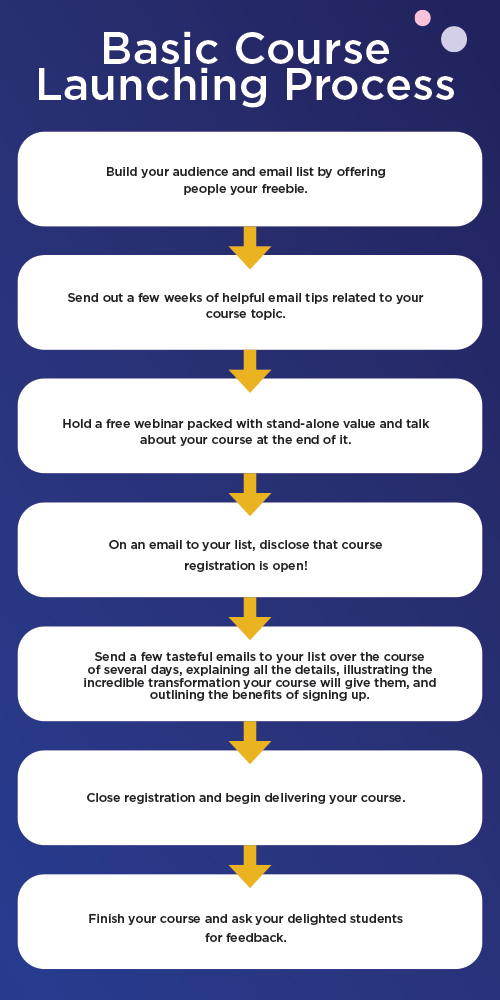Captive Audience
| November 1, 2022Can you make real money giving an online course? A copywriter shares the pitfalls course creators face, and how to circumvent them

C
hasya is a talented artist. She’s spent years perfecting her watercolor technique. Her blue jays are almost soft to the touch. Her snowy-tree scenes make you shiver.
At a friend’s request, she began giving art classes to a small group of local women. Their raving feedback made her realize that she loved imparting the magic of what she was doing to others almost as much as she loved to paint. After every session, she returned home on a high, and compelled her bemused husband to look and listen as she excitedly flipped through pictures of her students’ work like a proud mother.
Then Covid struck. She created some beautiful pieces alone in her studio, but some of the magic had dissipated. She wanted her students back. And they wanted her.
“Get on Zoom!” they begged. “It won’t be the same, but it’ll be something.”
Her husband mounted a camera in her studio and Chasya started to teach again. It felt wonderful to back in touch — and the income was nice too.
After several weeks, her husband threw a suggestion out at the supper table. “You know, Chas, why don’t you create — ich veis — a six-session video art course? Then you could sell it and bring in nice, passive income.”
Chasya loved the idea. If her students enjoyed her classes so much, why shouldn’t so many other women out there? She could reach hundreds of thousands of students. With the online world of today, even the sky wasn’t the limit.
She got to work, shooting and re-shooting, editing and cutting, crafting her videos with the same love and devotion as she invested in her classes.
Finally, the day came when she stumbled out of the studio bleary-eyed at 1 a.m. She was finished.
The next day, still on a high, she wrote out an ad. Her daughter, a graphic-design dabbler designed it. She excitedly called a few local publications to run the ad in their next issue. And then she waited.
At the end of the week, she tallied the interest. One sign-up (her best friend), one maybe, and three phone inquiries.
Self-doubt started to kick in. Why did no one buy if her ladies loved her classes? She wasn’t expecting 100 sign-ups. But ten minimum! Perhaps it wasn’t such a great product after all. It was a saturated market. And what about all the ladies that loved her classes? Where were they?
“Look, you have to give it time,” her husband told her. “Word needs to spread. The first lady does it and raves about it to her friends. Then her friends buy it. Word of mouth. You’ll see!”
But five months, two sales, and three ad rounds later, Chasya isn’t so sure.
AS
a kid, Avigdor was always on the computer. But he wasn’t crushing his score on Midtown Madness like most of his friends, he was coding basic games in Python that his younger siblings were always eager to try. He would code, run tests, debug, and then let them go for it. Inevitably, they would find more bugs, which he eliminated until the code was perfect. He loved challenging himself to write the shortest, most concise code that would still get the computer to do what he wanted.
When he left for yeshivah, coding was relegated to bein hazmanim. It was still fun, but learning was now his thing.
Eight years later, he was married and sitting in kollel. His wife’s parents were stopping their support in just two months, and he hated the thought of leaving full-time learning. But he didn’t have a choice, unless… he pulled out his dusty programming skill and somehow monetized it.
Walking home one day with his chavrusa, he suddenly had a brainstorm. Why not create an online coding course? He could give it once a week, with homework, and make good money while he sat and learned the rest of the week.
After three weeks of hard work bein hasedorim, Avigdor had his course outline. He began to work on his lesson plans. It took him four weeks to do the first five. By then his wife was nudging him to advertise already. They were going to need money very, very soon.
Four rounds of advertising later, he had his first cohort of… two. While he was tentatively optimistic that his business would grow, he was pretty disappointed. All that hard work and advertising and just two students? His ads must have been seen by thousands of people! Where were they all?
The Pull
It seems like a stroke of genius. Package your wisdom into a saleable product and convert it into wealth!
You’ll have your own business, your own hours, and you’ll do what you love most. I mean — people will actually pay you to talk about your pet topic for a couple of hours straight.
But somehow, it doesn’t always work out like that. Most course creators find themselves in situations similar to those of Chasya and Avigdor. They know their course is great (it is great!) and there seems no reason that it shouldn’t sell. Why doesn’t it?
The answer: A successful digital course needs a strong marketing strategy to be successful.
It’s rarely the course itself that’s the problem. Live or filmed; with homework, question-and-answer sessions or without; email communication with the creator only or entrance to a likeminded community — none of these components are what make or break a course. If the creator knows what he’s talking about and can sincerely help others with his knowledge, he’s definitely onto a good thing that will sell.
It’s usually the marketing that’s causing all the problems. As you might have guessed, a few rounds of advertisements aren’t going to cut it. The marketing process must be highly intentional and follow a specific strategy. Most of all, it must include three critical components. Let’s explore them one by one.
Here’s the first: Audience.
Who Cares?
The truth? Creating a course is a great idea. There’s never been a better time to create an online course. The online course market today is exploding.
According to Forbes, the worldwide e-learning market, or digital-course market, is projected to be worth $325 billion by 2025. GlobeNewswire claims that the US e-learning market could increase and grow by $12.81 billion between 2020 and 2024.
Because of Covid, right? You couldn’t go out to your pottery class, so you found a way to learn it online. While the pandemic definitely explains why the numbers have skyrocketed within the last couple of years, the industry was growing before the pandemic too, thanks to the Creator Economy.
Thanks to the… what?
Before the year 2000, if a typical American — let’s call him Tim — wanted to ditch his nine-to-five and monetize his favorite hobby — folding origami birds — it was a long, dreary journey. He had to build up from door-to-door sales until some big corporation agreed to display his birds in their stores. That was when Tim, officially, “had it made.”
Today, thanks to the advent of social media platforms, Tim will first head there. He’ll post pictures of his latest birds, create how-to videos, and publish lists of origami tips. His initial revenue will not come from birds sold to family and friends, but from ads people clicked while viewing his content. Tim has become a “creator.”
With time and talent, Tim becomes a celebrity in the origami industry. He’s got a website selling his creations that gets hundreds of visitors a day, a popular live online presence, and a 10,000-strong email list.
It’s then that he decides to create an online course. It’ll be an eight-week origami-folding bootcamp. He’ll teach how he comes up with new bird ideas, the types of materials he uses, and how he sells his birds successfully.
The course sells like hotcakes. His followers have been pleading for this kind of thing for ages already. Within the first hour of his course launch, he has over a hundred sign-ups.
Tim first developed his audience, and when they were ready and waiting, he gave them a product he knew they’d love — his course.
Chasya and Avigdor, on the other hand, worked backward. They created a course they thought people would love and tried to sell it. Without a waiting audience, it was tough going trying to rustle one up. And the sales showed it.
To sell your online course, you need a strategy. And that strategy must incorporate audience building.
(Just in case you’re wondering, audience building does not necessitate the use of social media. Social media is not a must for a course creator who wants to build an audience. Yes, putting out a freebie on social media is the most typical method of audience building, but it’s by far not the only one. Public email lists, WhatsApp statuses, ads on well-known websites and blogs, and even print ads have been used very successfully. Figure out where your audience hang out most and try to meet them where they are.)
Next up: Your offer.
Product-Market Fit
When is the course? How long is the course? How much is it? What are we going to learn?
The answers to all of these questions describe your offer.
Your offer has to fit your intended audience. When you design it, you have to have them in mind, every step of the way. Here are some examples:
The amount of hours Rabbi Fried spent crafting his kitchen halachah course definitely warrants a price of over $500. But he’s fighting against a mentality of “we don’t pay for shiurim,” and asking even $50 is perceived by many as off the wall. Being realistic, he charges $57. Rabbi Fried is also careful to only launch at times of year that are practical for his mostly female student body — not during Elul or Nissan.
Hadassa’s top-quality course teaches beginner animators how to use Adobe Photoshop. She’s offering valuable information that will help her students establish themselves with a respectable profession, so she’s justified in charging $1,500. But because her students are still at the bottom of the ladder and not earning very much yet, it makes a lot of sense for Hadassa to have a payment plan available.
Dr. Shimmy’s course shows teachers how to handle kids with ADHD in a classroom setting. His course kicks off toward the beginning of summer vacation, when teachers have more time to invest in themselves. But he is careful to hold only one session a week, with little homework, so his students get a break too.
If your offer is perfectly aligned with your audience, poof! It will be flying off your virtual shelves.
What They Hear
Of the three elements a course needs to be successful, the third and most important one is messaging.
The words you use to talk about your course are ultimately what will persuade your students to buy. Those words need to drafted very carefully.
But how do you choose?
The key to hitting upon the perfect set of words lies with… your potential students. Nobody buys a course unless it’s going to solve a problem for them. It might be “I need to earn money.” It could be “I’ve been trying for years to learn piano, but the notes have never stuck in my head.” Or it could be “I want to sell on Amazon, but I need someone to show me the ropes.”
Understanding the problem your course is solving — and successfully presenting your course as the solution to that problem — is the key to drawing in customers.
You can try to guess your prospects’ problems and you’ll probably come up with some ideas. But the best way of identifying the problem is by taking the guesswork out of it completely —talk to your prospects. Get on the phone and have a good, long, old-fashioned conversation. Record that conversation and take notes. You’ll be surprised at how many original problems they come up with.
Later, pull the precise words that your prospect used to describe the problem and plug them straight into your promotional materials. Then, when your prospect reads your ad or your webpage, they’ll find themselves nodding right along with the words, “Yeah, me too!” Then when you present your course as the solution to that problem, they’ll be feeling for their credit cards.
Building Your Audience
Well done! You’ve started ticking your boxes. You crafted the perfect offer. You know the problem your course is trying to solve. But you’re wondering how you’re meant to start building an audience.
You’re not particularly well known. Outside of a few kids you’ve tutored, and a few people who attended a workshop last January, you’re Mr. Anonymous. Where are you going to get all those people lining up to take your course?
Before we figure that one out, let’s investigate another problem.
Picture this. You’re standing on a soapbox outside Madison Square Garden and talking to the world at large about your course. Ninety percent of passersby have no interest in what you have to say. Five percent stop and listen but quickly move on. Another 4 percent seriously consider your offer but come up with a plethora of good reasons why it won’t work for them. The remaining 1 percent pull out their wallets and say, “How much?”
As you step down, disappointed, you think ruefully about the 9 percent of people who expressed some interest but didn’t buy. You’re convinced that if only you’d been able to grab their attention again, or showcase your product more effectively, they’d see how you could help them.
You have two options. Either you can give another speech and hope the same people come back. Or you can station your brother nearby with a pen and paper to record everyone’s phone numbers. Later, when the speech is over, you’ll call these people and follow up.
When you run an ad about your course, it’s just like you’re standing on your soapbox. Along with the 1 percent of people who did sign up, there are 9 percent of people who might have if only you’d gotten into conversation with them again and showed that you cared.
You have two options: You can run another round of ads. Or you can figure out a way to get the contact details of the people who expressed interest.
The solution to this problem — and the audience problem — is a freebie.
Create a pro bono resource that will solve a small part of the big problem your prospects are facing. “Ten Photoshop design hacks.” “A surefire way to memorize music notes so you know them in your sleep.” “The most effective method to get your kid to eat his greens.”
Everyone likes a freebie. When you offer something at no cost that solves someone’s problem, you sweep away the biggest objection of all time — “I have no money to spare for this.” Your prospects will be delighted to get a hold of it. But you build in one caveat — they must part with their email address in exchange.
Email address in hand, you can engage with your prospects again. Now, here it’s important to note: your prospects need to want to hear from you again. If they don’t, they’ll stop opening your emails and divert them to Spam.
Course creators are not in the business of making money. They’re in the business of helping people see results and change in their lives. If your email contacts have no interest in those results or those changes, you’re speaking to the disinterested 90 percent, and you’re wasting your time.
Once you have a decent-sized email list, you have both your audience and the ability to engage with them again. You’ll no longer be speaking to the world at large. The people on your email list have chosen to be there, because by claiming your freebie, they have demonstrated interest in your area of expertise. And your carefully crafted, non-invasive, follow-up emails will hopefully bring results.
Keep Them on Their Toes
You’ve made it! You’ve built an audience, created an offer, and refined the message. It should be smooth sailing from here on… right? Here’s one thing that course creators will want to take into account.
The retention rates for an online course today can be as low as 15 percent. That means that only a fraction of the people who begin the course will finish it.
The reason for that is pretty obvious: There’s no social pull to turn up to classes on time with a series of pre-recorded videos. Learners procrastinate or lose interest. The charisma of the speaker, and the dynamic atmosphere of a packed classroom, are lost. Live-streamed courses are better, but even these offer recordings that many students comfortably tell themselves they will take advantage of… and miss the live class.
Dropouts affect the course creator negatively because people who don’t complete a course don’t recommend it to others or leave glowing testimonials. They will also never buy any future product the course creator makes.
The best way to combat this is “gamification.” Your course should be a game, a pile of fun to complete. Provide checklists your students can use to track their progress. Offer surprise bonuses or prizes at strategic stages of the course. Give challenges with deadlines. Make your course an enjoyable, motivating, empowering experience upon which your students thrive.
Jumping In
Should you create a course? Yes, you should! If you have information that cam make others’ lives easier, it’s your sacred mission to share it. With your online course, you can reach many, many more people than an in-person class or one-on-one consulting. That means a tremendous impact and limitless growth potential. In the world of course-creating, $10k, $20k and $50k launches are commonplace. And that’s in almost any niche you can possibly think of.
But don’t be fooled into thinking that now that you’ve left your nine-to-five, you can start taking it easy. Creating and marketing a course is a tremendous amount of work. Even if the course didn’t take you long to plan, the marketing must be done properly before you start seeing results.
One day in the future, when you’re confident that you have a successful product in hand — yes, you will be able to fully automate the process and watch the sales roll in by themselves. But there’s a lot of work (albeit rewarding work) that needs to be put in before that.
Don’t let that daunt you. The world is waiting to hear your message.
How do I create a course?
1. I would love to create a course, but I have no particular expertise. I don’t know graphic programs or how to trade stocks and shares. What would I teach?
Most people do have something valuable to teach, but just don’t realize it. Ask yourself, what am I doing now? If you’re working in any industry, it’s extremely likely that you have specialized knowledge, gained on the job, that people outside your industry do not know and would not find intuitive.
And even if your answer is “I’m a stay-at-home Mommy and always have been!” there is no doubt in my mind that you can find one area of parenting or running a home that you could teach. Here are some ideas:
How to bake or cook a speciality item.
Easy, fun, and original ways that can save you $500 dollars a month.
How to develop the mind of a 9- to 24-month-old through play.
How to fix basic household appliances.
How to cut oil, refined sugar, and white flour out of your family’s diet without them noticing.
And the list goes on!
One caveat: You have to be able to give over information in an engaging, easily consumable fashion. I once tried to work with someone who was brilliant but incapable of breaking down information. That course did not materialize. But even if that’s you, there’s still a way out — you can hire someone to do it for you!
2. I have an idea for a course, but someone else did it already. Should I bother?
Of course! As Course Launch Strategist Shalva Rosenberg put it:
“There’s plenty to go around, and you have a different way of doing it than the next person. Don’t worry about them. Wish them the best, hope their course goes fantastically well, and know that some students will connect better with them. And also know that some students will resonate more with you.”
If fact, if there are no courses is your niche at all (I don’t mean only in the “Jewish world”), you might want to find out why.
3. How much should I charge for my course?
The basic guidelines are:
- Foundational course, starting students on the beginning of a journey: $100–$200
- Laser-focused course designed to help students achieve one goal: $200–$500
- Comprehensive course, teaching students everything you know: $500–$2,000+
But of course, that’s only a ballpark range. My best answer is:
1) Look at what other people in your niche are charging.
2) Figure out what your target student would spend by surveying them. (Tip: Don’t ask, “How much would you pay?” Ask them, “Would you pay $100/$300/$500 for a course about [your subject here]?)
3) Figure out how much people are paying for alternatives and go a little cheaper. For example, if people are paying $500 a session for one-on-one coaching, to solve the same problem your course can solve, you can price your course at $1,000 and tell your potential students that the price of the course is equivalent to two sessions with a coach, but will give them skills that are equivalent to ten sessions’ worth.
4. Why would anyone invest in a course if they could go to YouTube and get it for free?
Because they usually can’t. It’s rare to find the channel that will walk them step-by-step through achieving the transformation they are looking for.
Because they can’t learn from you for free! This applies if you have a reputation in your industry or if your audience trusts you.
The convenience of not having to sift through so much free stuff! You’re handing it to your students, neatly packaged on a plate.
You get what you pay for. People posting free content aren’t invested in getting them the results they signed up for.
Putting money down is a tried-and-true way of holding themselves accountable.
5. I know how to do something, but I’ve never been trained in it. Can I legitimately teach it?
Yes, if you’ve got real, quantifiable, exhibitable results for yourself or someone else, you can teach it. In a world that celebrates wealthy college dropouts, people are realizing that it’s the results you can get them that matter, not only the fancy letters after your name. This is especially true in the frum world — training is not a given in most fields outside the medical, therapy, and finance fields. Our communities are full of heimish yeshivah graduates who have risen to the top of their industries through sheer grit and brains, and are considered experts by Jews and non-Jews alike.

Sara Peltz is a Launch Copywriter and Architect who loves to help course creators see the returns their quality courses deserve. She can be contacted through Mishpacha.
(Originally featured in Mishpacha, Issue 934)
Oops! We could not locate your form.







